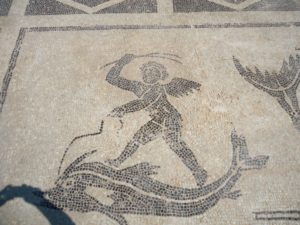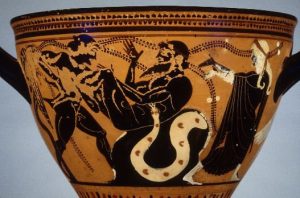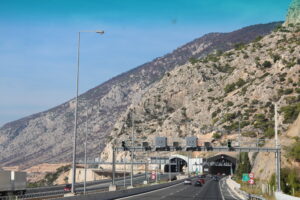The Molurian Rock: Ino and Melicertes escape Athamas
τότε δὲ φεύγουσα ἐς θάλασσαν αὑτὴν καὶ τὸν παῖδα ἀπὸ τῆς πέτρας τῆς Μολουρίδος ἀφίησιν, ἐξενεχθέντος δὲ ἐς τὸν Κορινθίων ἰσθμὸν ὑπὸ δελφῖνος (ὡς λέγεται) τοῦ παιδός, τιμαὶ καὶ ἄλλαι τῷ Μελικέρτῃ δίδονται μετονομασθέντι Παλαίμονι καὶ τῶν Ἰσθμίων ἐπ᾽ αὐτῷ τὸν ἀγῶνα ἄγουσι. τὴν μὲν δὴ Μολουρίδα πέτραν Λευκοθέας καὶ Παλαίμονος ἱερὰν ἥγηντο:
The robber Sciron tosses travelers into the sea
τὰς δὲ μετὰ ταύτην νομίζουσιν ἐναγεῖς, ὅτι παροικῶν σφισιν ὁ Σκίρων, ὁπόσοις τῶν ξένων ἐπετύγχανεν, ἠφίει σφᾶς ἐς τὴν θάλασσαν. χελώνη δὲ ὑπενήχετο ταῖς πέτραις τοὺς ἐσβληθέντας ἁρπάζειν: εἰσὶ δὲ αἱ θαλάσσιαι πλὴν μεγέθους καὶ ποδῶν ὅμοιαι ταῖς χερσαίαις, πόδας δὲ ἐοικότας ἔχουσι ταῖς φώκαις. τούτων περιῆλθεν ἡ δίκη Σκίρωνα ἀφεθέντα ἐς θάλασσαν τὴν αὐτὴν ὑπὸ Θησέως.
- Map
- Pre Reading
- Post Reading
- Culture Essay
With the advent of the modern highway and tunnels, it may be hard to imagine the perils of this rocky, precipitous road named after the robber Sciron. J. G. Frazer in his commentary on Pausanias describes this narrow pass between the cliffs and the sea as follows: “For six miles it ran along a narrow, crumbling ledge half way up the face of an almost sheer cliff, at a height of six to seven hundred feet above the sea. On the right rose the rock like a wall; on the left yawned the dizzy abyss, where, far below, the waves broke at the foot of the precipices in a broad sheet of white curdling foam. So narrow was the path that only a single sure-footed beast could make its way with tolerable security along it. In stormy or gusty weather it was dangerous; a single slip or stumble would have been fatal. When two mules met, the difficulty of passing each other was extreme” (2:547). Between the rocky crag (πέτρα –ας, ἡ a rock, a ledge or shelf of rock) and the narrow pass (τὸ στενόν) Alciphron (3.70) reports that travelers faced the added horror of robbers who lay in wait on unsuspecting travelers.
The second tale Pausanias tells about the Molurian Rock centers around Theseus and Sciron, a villain who cast into the sea all who attempted to pass this narrow byway. As one might expect, Theseus saves the day. Read the culture essay on Theseus’ Six Labors.
Review -μι verbs
How does Pausanias show his learning in his discussion of Sciron?
The first sentence of the Ino passage is many lines long and contains a lot of subordination. Break it up into four or more shorter sentences in Greek.
Consolidate your knowledge of participles with this Participle Review-Post-reading-RoadtoCorinth.
Pausanias’ version of the Sciron tale tells the same story but is much briefer and differs in detail. Re-read the version from the Library and then write a more complete account of Sciron and Theseus.
N/A



Photograph by Maria Daniels, courtesy of the Toledo Museum of Art, January 1992. Toledo 1963.27
